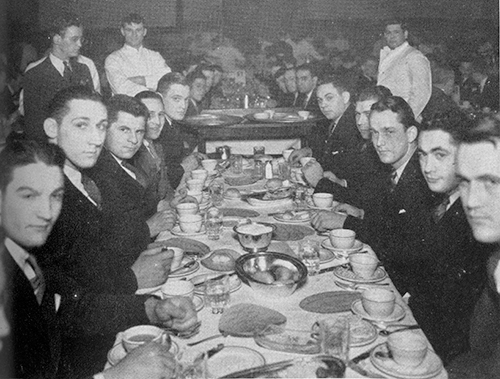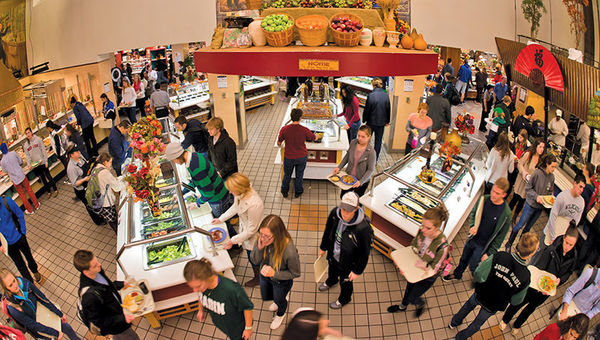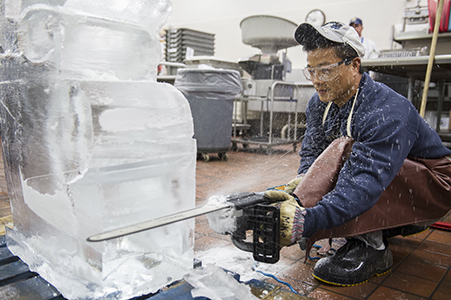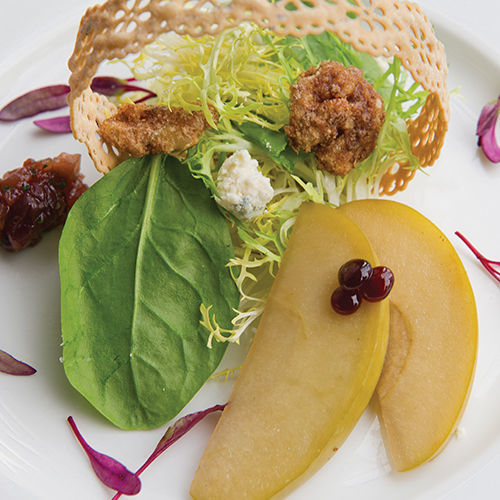Just how does Notre Dame’s food stack up in 2013? The University built its reputation for innovation and excellence under the late Food Services director, David Prentkowski. The student survey-driven Princeton Review says Notre Dame is a solid No. 13 on its annual Best Campus Food list, but it had reached the top 10 in recent memory thanks to the strengthened interaction between students and servers, and the variety and freshness of the food. Udi’s Gluten Free awards ND a No. 1 national ranking and says dining at Notre Dame is a piece of gluten-free cake. The future looks even better. New Food Services director Chris Abayasinghe arrived in October with a mission: cut wasteful business and culinary practices, and return savings in the form of better quality food.
For all the clamoring about variety and flavor, and with a menu that features some 80 to 110 different entrees, soups, sauces and sides, what are students’ most popular dining hall choices? Grilled chicken breast and Diet Coke.
Most popular deli meat? Turkey
Cheese? Provolone
Soup? Chicken in a pot
Sandwich? Grilled cheese
Pie? Reese’s peanut butter, of course.

Mealtime in 1930 would be unrecognizable to today’s buffet-going students. “Each meal, from start to finish, lasts exactly 25 minutes,” historian Thomas Schlereth ’63 recounts in The University of Notre Dame: A Portrait of Its History and Culture. “At the sound of the first bell, the students, dressed in suit jacket and tie, marched in formation through specifically designated hall entrances and proceeded to take their seats at tables set with silver and china. They stood there in silence until grace before meals was said by the presiding official. The University president held this position in the east hall, and the prefect of discipline bore this title in the west hall. Another bell rang, all sat down, and the waiters brought on the soup. At the next signal, the dinner was served. Finally, the closing grace was said, and the students quietly left the hall in orderly lines.”
The Great Milk Riot occurred during the 1951-52 school year when, as a cost-saving measure, the dining hall switched from 10-ounce to 8-ounce glasses. One student showed his displeasure by hurling his milk glass against the wall of the dining hall. Others soon joined the protest with relish — whipping and smashing their milk glasses against the walls. The larger glasses reappeared the following day.
By the numbers
1¼ Ounces in a fresh-baked cookie drop in 2013. That’s down from 3 or 4 ounces a few years ago (and not a word of complaint, chefs say).
2:30 is the early-morning hour when the 24-hour bake shop starts to bake the daily bread.
14 Flats of strawberries (and another 10 or so of blueberries) that 400 soccer-playing girls devoured one summer morning. Sports campers eat some 55,000 meals at North Dining Hall each year.
19 Average adult rhinos needed to balance out the 155,913 pounds of pasta cooked in 2012.
25 Campus buildings where Food Services serves food (or at least prepares it).
124 Dozen iced shamrock cookies that Bobbie Porter and her colleagues baked for the USC football weekend, “and we didn’t break a one!”
178 Farms supported through the ND-Stanz local produce program.
800 Pounds of ground beef in a typical batch of taco meat (plus 200 pounds of onions).
1,000 Pounds of heirloom tomatoes harvested from Food Services’ garden, which also produces strawberries as well as chives, rosemary, thyme and other herbs.
6,000 Hours that apprentice chefs spend over three years rotating through all of ND’s kitchens to learn their trade.
9,000 Daily transactions at ND’s 18 restaurants, cafes, snack bars and convenience stores — more than 2.3 million cha-chings per year.
85,000 Gallons of milk gulped down in the dining halls annually. It does the body good.
530,439 Complete meals plated by Notre Dame’s Catering By Design service in 2011.

“Forty-five hundred meals a day takes a lot of focus.” — Chef Giuseppe Macerata, culinary production manager for North Dining Hall and ND Catering
The Great Cereal Protest exposed a flagrant divide between the student body and University administration. The removal of Cap’n Crunch from the dining halls incited protests and a 1984 appearance of the Cap’n himself, prompting The Wall Street Journal to report: “After a sit-down strike, students at the University of Notre Dame have won their demand: an unimpeded supply of Cap’n Crunch, their favorite breakfast cereal.” It’s still a favorite.
The typical student meal plan in 2013 includes 14 meals per week plus 380 flex points that students can use for coffee, snacks or full meals at most campus establishments by swiping their ID card. Beyond that, Mom and Dad can load the ID with Domer Dollars, a way to pay at on- and off-campus locations, including the Bookstore, the Huddle, Chipotle, Domino’s Pizza, Five Guys and Jimmy John’s. In January, the ID will be rebranded as the Irish1Card to expand discount programs and reward benefits.

“I like tools. I like art. So it works out for me.” — Meat cutter Howard Busfield, one of three Food Services employees who wield a chainsaw to create stunning ice carvings for catering displays, often from their own original designs. It takes an hour or two to complete a standard ice leprechaun, which can last up to six hours before it melts beyond recognition.
Theme meals are a dining-hall tradition that don’t just showcase ethnic cuisines. A few years ago, when the world’s favorite boy wizard was of age to attend Notre Dame, Harry Potter dinners at South Dining Hall featured Hogwarts décor, a potion station and familiar Potter fare from butterbeer to treacle tarts. Perhaps the most cherished theme memory, though, is Circus Lunch, circa 1992, when the dining halls became pseudo-Big Tops festooned with balloons and banners. Greeters and servers wore face paint, red noses, crazy wigs and clown shoes, and the menu featured junky but wonderful circus treats — corn dogs, Twinkies, circus peanuts, popcorn and, yep, cotton candy.
“It’s a crazy business, and you gotta have fun or you better not be doing it.” — Food Services Support Facility general manager John Glon
Training table is a staple of elite college athletics programs designed to promote team unity and provide expert-guided nutrition tailored to the athletes’ needs. NCAA rules allow one team meal per day. The custom was long resisted at Notre Dame, then practiced under coach Lou Holtz, then discarded until the University reinstated it in 2010 under coach Brian Kelly. Now the football team gathers for dinners at The Gug. Meanwhile, North Dining Hall hosts an All-Sports Room where, Monday through Thursday, the student-athletes in other sports eat their evening meal. The food is essentially the same, but Athletics Department nutritionists work with chefs to create especially healthy preparations — more vegetables, lower-fat cooking oils — that sometimes find their way back into the mainstream menu. Students didn’t notice, for instance, when the heavy cream disappeared recently from the popular four-cheese pasta. They just kept eating it . . . like champions.
Quick quiz:
1. Say I’ve got about 10,000 people coming over for lunch and dinner like they do at Notre Dame. How many pounds of hamburger do I need for a pot of chili?
A. 100 B. 300 C. 1,100 D. Throw in the whole cow
2. What time of day do the Food Services trucks start loading for breakfast service?
A. Midnight B. Whenever C. 4:30 a.m. D. My alarm clock doesn’t function that early
3. True or False: People will break off and eat pieces of the Sugar Leprechaun centerpiece anchoring the sweets table at the President’s Luncheon on gameday. (It is a giant lollipop after all.)
Answers: 1. B; 2. C; 3. True. But, really, don’t do that.

The coolest thing on the menu? Our choice is the cherry caviar most recently served with a roasted Michigan apple salad and a unique cracker designed by lead pâtissier Laura Johnson for the November Business Advisory Council dinner. Chef Charu Pant combined Michigan cherry juice and unflavored agar-agar or gelatin and released droplets from a syringe into a superchilled vegetable oil. The process, a kind of simple molecular gastronomy, spherifies the juice to look like pearls of red caviar that burst with fresh cherry flavor.
“I started in ’68. All this time, until the Food Network came on, I didn’t realize that I worked in a glamorous job.” — Executive chef Donald Miller
Compiled by John Nagy ’00M.A., Kerry Temple ’74, Tara Hunt’12 and Jamie Reidy ’92, with special thanks to Notre Dame Food Services.